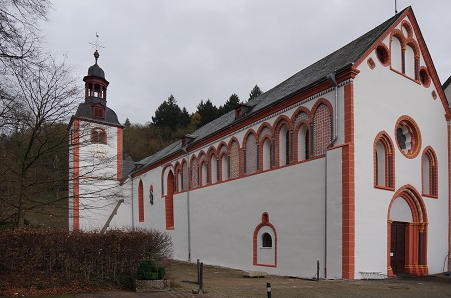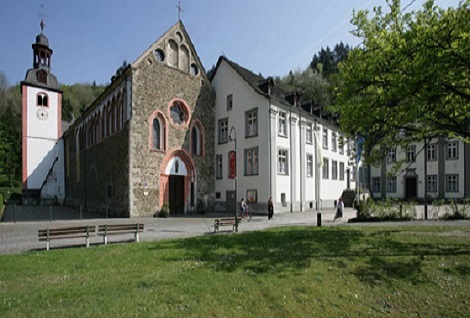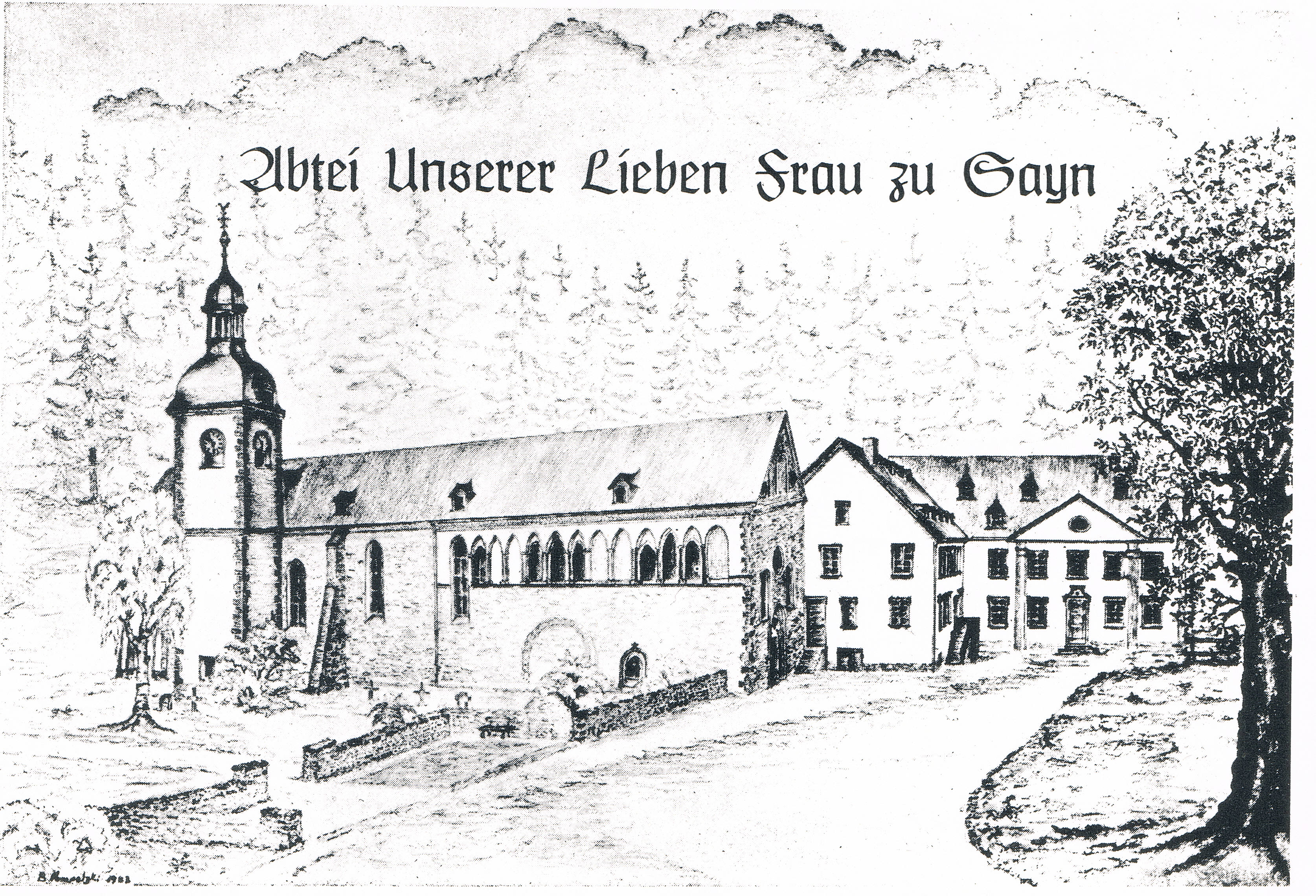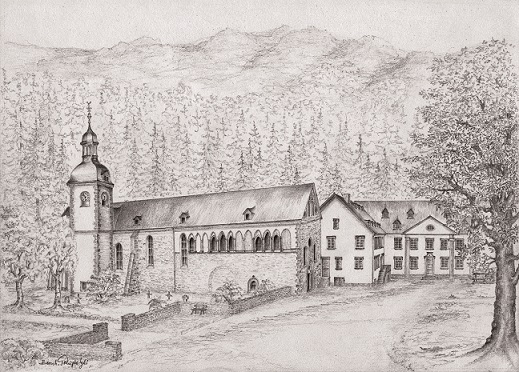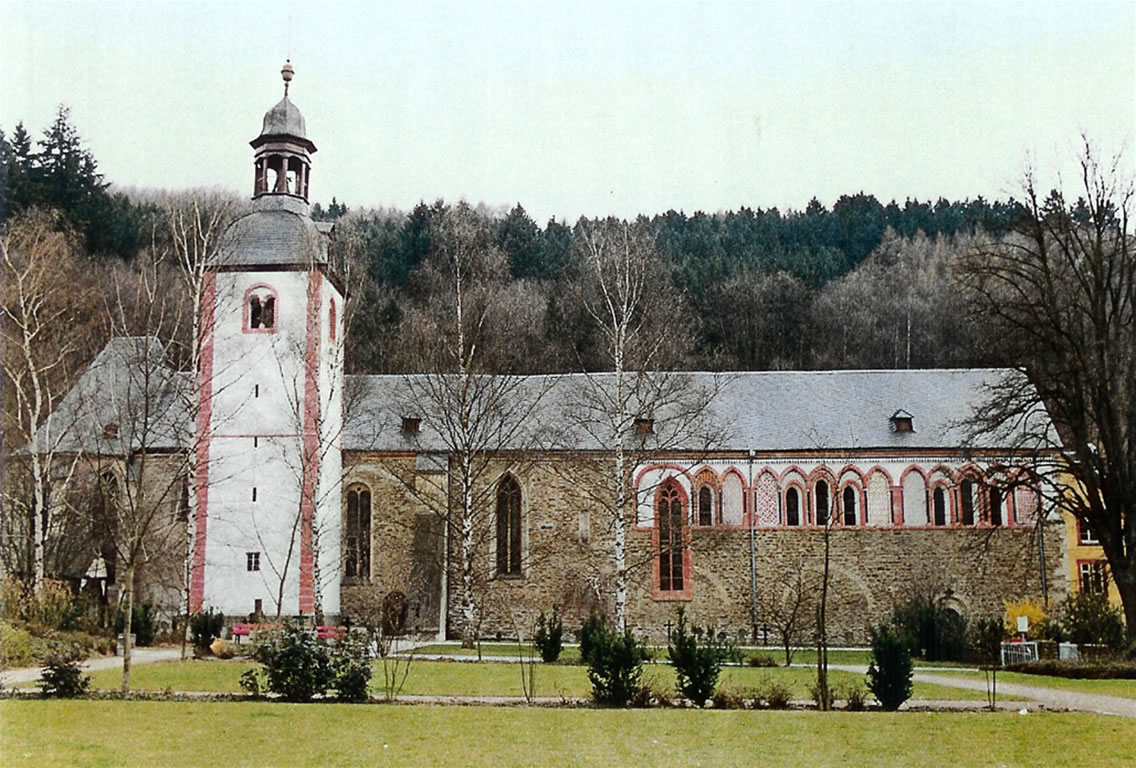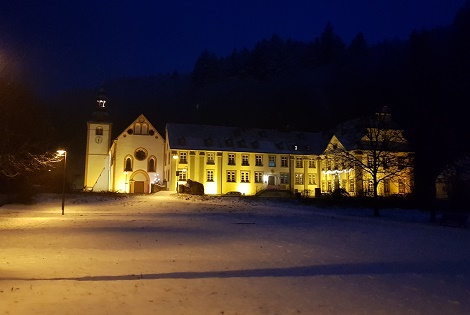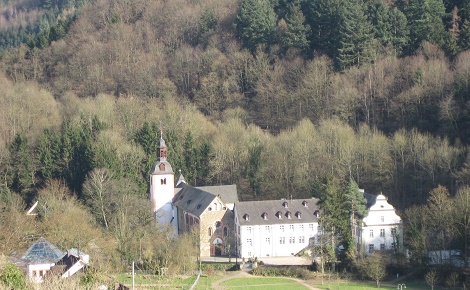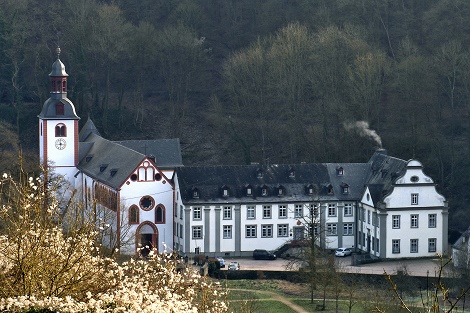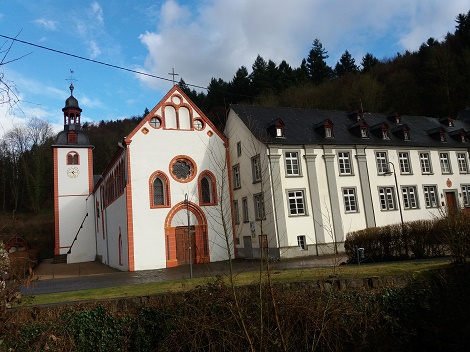To the history of the abbey Sayn
As the earls of Sayn were at the height of their power at the turn of the 12th to 13th century, Earl Heinrich II decided to found a monastery named “to the honour of God and in the hope of eternal retribution” near to his fortification and to equip it correspondingly with the necessary possesions. One place seemed to be most suited, it being a hundred metres in to the valley, above the town of Sayn and in the neighborhood of the earl’s fortification. Here there was already a larger chapel dedicated to Saint Nicolas belonging to the Engers community.

Earl Heinrich was able to enroll the help of brothers of the Premonstratensian Order (Order of the Norbertines) to found the monastery. This reform-oriented order, founded by Norbert of Xanten in 1120 in Prémontré in France connected monastic life with active spiritual welfare work in the community. It attracted youths and soon caught on. Earl Heinrich turned to the then famous abbey Steinfeld in the Eifel region. Its abbot Ehrenfried sent twelve clergymen headed by provost Hermann to help set up the monastery. In accordance with the order rule Sayn remained a daughter monastery, subordinated to the father abbot of Steinfeld for all time and as such was sure of the help of the rich and powerful abbey. A regional particularity was that not far away there was a further Premonstratensian unit: Rommersdorf as founded by the abbey Floreffe (Namur).
On the fourth Sunday after Easter in 1202 the abbey church in Sayn the solemn consecration of the abbey church was held by the papal Legate Cardinal Guido of Praeneste in the presence of numerous top clerical and worldly guests. At the same time the fortification and valley Sayn were separated from the parish of Engers and became an independent parish under the patronage of the new abbey.
In the confirmation deeds the possessions of the abbey are mentioned, these in the main coming from the benefactor, Earl Heinrich II and his brothers Eberhard, Bruno (the later Archbishop of Cologne) and Gerlach. The possessions increased throughout the years thanks to the donations. Earl Heinrich III (died in 1247) and his wife Mechthild deserve a special mention. With this economic foundation, capable abbots were able to lead the abbey to prosperity, this continuing till around 1500.
The renown of the abbey was heightened by the possession of a precious arm relic from the holy apostle Simon which was a present from Cologne Archbishop Bruno II, in 1206. Sayn as such became a destination for pious pilgrims. In accordance with a contemporary depiction in the year 1509 there are said to have been 22 000 pilgrims one Sunday gathered in front of the church.
The abbey’s chronicle reports on numerous healings that took place throughout the centuries. The water in the Simon well, which is behind the church and in which the arm relic was hidden in times of war, was said to have healing powers. In order to keep the relic safe in the long-term the brothers had a shrine made, seemingly in a workshop in Trier (probably at St.Maximin’s) that today can be seen on the high altar. Because of its quality and its design it is recognized as one of the famous Rhenish relic shrines.
The time of prosperity was abruptly brought to an end by Levin von Gouda’s (1500-18) mismanagement of the abbey, which took it to the brink of the abyss. His successors were able to reduce the abbey’s debts after years of hard work and to buy back pawned goods, but it wasn’t possible to reinstate the former state.
In the following period the consequences of the Reformation threatened the abbey’s very existence. Earl Adolph of Sayn introduced the doctrine of Martin Luther from 1561. The same year he robbed the abbey’s entire church treasure. The Nicolas chapel was first assigned to a protestant preacher and when this became dilapidated the main nave of the church also had to be given to the Protestants. Forced payments at times as high as half of the abbey’s income led to complete economic ruin.
When Earl Heinrich IV died in 1606 without heirs, the fortification and the town of Sayn fell to the Electorate of Trier in accordance with the fiefdom contract dating back to 1152. Trier kept the abbey, in which at times only one canon lived, from what would have been certain ruin. From then on with the help of Steinfeld it went slowly uphill. Under the abbots Gülich and Colendal the abbey entered a new heyday.
During the 18th Century the abbey developed in a continuously favorable way. Again and again its exemplary discipline and well managed finances were pointed out. The abbots Ohm and Hirsch began to authorize building again.
In the last decade of 18th century there was a new disruption on account of French revolutionary troops coming and their being accommodated. On account of the conditions of the federal deputation decree the abbey fell to Frederic of Nassau who dissolved it on 12. June 1803. As the parish church was incorporated in the abbey, Nassau took over the obligation to maintain the church building and parish accommodation. A part of the monastery building became a school in 1824.
Maintenance of the church and parish house had to be done by Nassau and – from 1815 – Prussia as legal successor to the abbey. Sayn became a patronage parish and the last abbot remained as the first patronage parson in Sayn. After Rhineland Palatinate’s foundation in 1947 rights and obligations were performed hereby. The state’s obligation to maintain the church should be mentioned here.
Regarding the history of the building of the abbey.
When the abbey was founded the brothers stuck to the example of the Steinfeld mother church whose planning they adopted in the main. However from the start the Sayn church was a one-naved church as a result of local conditions. On the north-hand side the old Nicolas chapel was connected with the new part by two arches. On the south side the cloister was built directly next to the long house.
The foundations of the Romanesque apse were found during excavations (1988-1990) and their location in the monastery, which was changed to the gothic time, is now indicated by a brass strip. Over the crossing of the long house and transepts a bulky bell tower of square shape was erected with three round arched windows on each side. Of these windows only one side was maintained during the Baroque period when newly built.
To complement the southern transept – following the Steinfeld example- two choir chapels were built which are marked by their very original and witty vaults.
The nave of the church was connected on the North-hand side (facing today’s cemetery) to the Nicolas chapel and opened towards it. As on the opposite side some passage ways were incorporated, the impression was created that the church had three naves.
The builders – in particular with regard to the windows of the long house and the west facade – followed local mid-Rhenish tradition. Whilst in the South wall there are fanned windows with seven parts of a twelve pass, the upper part of the northerly outer wall over the roof of the Nicolas chapel there is a division of five blind arcades each with three tiered windows. And also the stone work of the high west facade is favorably divided by six windows and blind arcades. Pointed arches, windows and arcades show the Gothic influences whilst the colorful outer decoration corresponds with the artistic notions of the Staufer period. Traces of colourful painting can be found in all parts of the church, in the area of the blind arcades at the North wall it has been created in the unique style of Rhenish art in such a way that the whole area is covered like a huge carpet with strong coloured patterns. Patterns similar to those of numerous enamels of Rhenish gold shrines.
Around 1230 the impressive Romanesque nave with its delightful well house was erected in which the well can be found made of two bowls crowned with a pine cone. The colourful design of the nave is supposed to symbolise -as is the case with the North wall - heavenly Jerusalem for the observer.
Church interior and altar
Thanks to willingness to donate on the part of the benefactors and the exertions of the abbots the abbey was richly equipped. The choir room with the choir stalls was only used for services for the monks. Originally it reached well into the long house and was separated by two altars from the rest of the nave where the worshippers were. Altogether there were seven altars in the church in those days. During the confusion of the Reformation and the thirty year’s war abbey life was depleted and part of the abbey was derelict. From the time before the Reformation the Romanesque christening stone with the frieze (1200) and the precious gold decorated shrine with the arm relic of Simon the apostle (1220) have remained.
Of the oldest church treasures the following should be mentioned: a small ivory shrine, now in Brussels and a portable altar (both early 13th Century) today in the British Museum in London. The treasure that Earl Adolph 1561 had taken to his fortification after his conversion to the Reformation has since been lost, this being over 24 Communion cups, three monstrances, three incense holders , silver candelabras and an abbot’s staff that was donated by Duchess Mechthild – its value then being estimated as being around 1000 gold gulden. Abbot Colendal (1698-1719) had the abbey rebuilt and the church building renovated in the lively Baroque style. As early as 1698 the sculptor Bruell from Cologne erected a Maria and a Norbert altar on which the order saints Hermann Josef and Gottfried Kappenberg were depicted.
The same artist also had a submission in 1708 for a new high altar which – with its impressive bulky three column architecture and carvings of lively figures - filled the breadth of the nave. This altar as with many of the other ornaments was removed during the first half of 19th Century because of ignorance. The following picture shows a reconstruction of the Baroque altar from an 18th century sketch in to which existing pieces were integrated. The similarity with the Baroque altar from Steinfeld is striking.
Only a few of the parts of the high altar remained as with the coat of arms of the benefactor Reiffenberg and Hoheneck and besides the carvings in the framework of the altar pictures of which the smaller one shows the resurrection, a work of the Cologne painter Meermann ((3rd case bay, North side). Of the large altar pictures which could be changed to fit festive occasions, the following are still there: St Simon with the Sayn shrine (mid-18th Century above the present day sacramental chapel) and a moving crib depiction following the Rubens school in the original frame ((3rd case bay, South side). Of the altar figures the apostle Simon (now in the transept) and apostle John (now 6th case bay, South side) be repaired as well as the apostles princes Peter and Paul (now on the Eastern buttresses of the intersection).
After the parish priest Holsinger had had the Baroque altar removed in as early as 1831 “as it was damp, rotten and worm-ridden” and in its place a step altar by Lassaulx had been put up, which again was replaced in 1861 by a simple altar and a high crucifix. Today unfortunately nothing remains of the step altar of the altar, of the altar from 1861 there is still a tabernacle (today in the wall of the choir) and the crucifix, which can now found on the southern side of the transept.
Today’s altar was not put in until the church was lowered in the 1980s and it was consecrated on All Saints 1997.
It is a reconstruction of the relic altar of the church of the former Premonstratensian convent near Wetzlar dating back to the early 14th Century. This altar seemingly commissioned by the Mother Superior, Gertrude, the daughter of Saint Elisabeth of Thüringen in 1300 no longer exists as a whole. The wing scenes depicting scenes of Maria’s life and Saint Elisabeth’s are exhibited in the Staedel Museum in Frankfurt, the high gothic figure of Maria in the Bavarian National Museum in Munich. The gothic architecture as a frame of the shrine is in the Elisabeth room in the palace of Braunfels.
The Sayn reconstruction includes in the compartments of the shrine the Simon shrine dating back to 1220 and other relics. The originally displayed arm relic of Saint Elisabeth from approx. 1240 returned to the altar of the Sayn chapel from Sayn palace in 2007.
After Vicar Hassinger had had the Barock altar removed in as early as 1831 “as it was rotten and worm-ridden”, in its place a step altar by Lassaulx was put up which again was replaced in 1861 by a simple altar with a crucifix. Today nothing remains of the step altar of the altar, of the altar from 1861 there is still a tabernacle (today in the wall of the nave) and the crucifix, which can now be found on the southern side of the nave.
Today’s altar was implemented when the church was lowered and was inaugurated on All Saints 1997.
It is a reconstruction of the relic altar of the former premonstratenser cloister Altenberg at Wetzlar dating back to the 14th Century. This altar commissioned by the mother superior Gertrude, daughter of Saint Elisabeth of Thüringen in 1300 no longer exists as a whole. The wing scenes depicting scenes of Maria’s life and Saint Elisabeth can be found in the Stadel museum in Frankfurt the high gothic figure of Maria in the Bavarian national museum in Munich. The gothic architecture as a frame of the shrine is in Elisabeth’s room in the palace of Braunfels.
The Sayn reconstruction includes the Simon shrine dating back to 1220 and other relics. The originally displayed arm relic of Saint Elisabeth from approx. 1240 was returned to the altar of the Sayn chapel form Sayn palace in 2007.
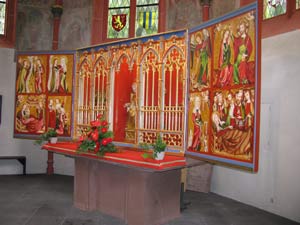
A Maria figure made of clay, the work of a local master (1737) which, on account of the size and the fine working which must be rare and of considerable value had to be removed from the wall for safety reasons and is now in the parish house. It was replaced in the wall with a modern one. As regards the origin of the Baroque pulpit, which seems to have come to Sayn in the 19th century, nothing is known. A new main altar as seen in the liturgy reform was made and can be found in the choir. The relic of a Roman martyr from the Calixtus catacomb named after the then pope Pius IX “Pius”. The pope gave this relic in 1853 to Princess Leonilla of Sayn-Wittgenstein for her parish church. Today it is kept in the right hand wall of the sacrament’s chapel. The church benches have recently been renovated in the baroque style.
Tombs
The abbey church used to be a great tomb house in which not only abbots but also local gentry and benefactors were buried. A large number of grave stones that used to be in the floor of the church over the graves are to be placed in the nave. But also in the church there are still numerous tombs, some of which are very valuable in terms of artistic value, remain. Only the most important are mentioned here.
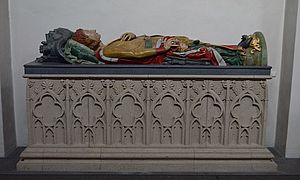
1.
Tomb of Earl Heinrich III
Probably the most significant work of art in the abbey is the larger than life tomb of the Earl Heinrich III (1247), which has been in the German National Museum since 1920 in Nuremberg. The copy in Sayn, which can be seen as being significant as here the original state of the medieval high tomb has been reconstructed.
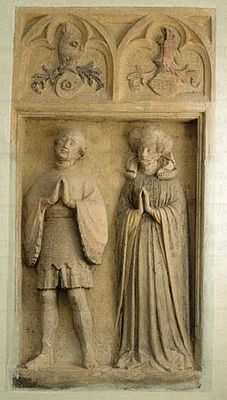
2. Tomb of Friedrich vom Stein and his wife Fye Voß v. Diebach
(fortification keep and owner of the fortification Stein set above the palace “Burg Stein”).
The couple are depicted with their coat of arms and the opulent local costume of the time (mid Rhenish workshop 1420, 2. case bay, south side).
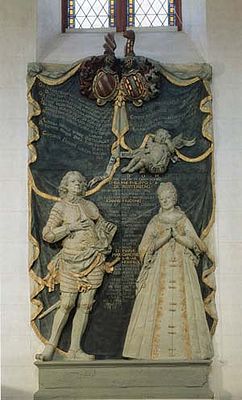
3. Tomb of Baron Johann Philipp von Reiffenberg and his wife Maria Margaretha von Hoheneck,
electoral high official and author of „Antiquitates Saynenses’;
excellent Baroque work with the crest of the family and the depiction of the deceased in representative pose and opulent clothing (1722).
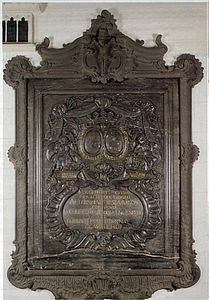
4.
Tomb of electoral minister Jakob Georg of Spangenberg
and his wife Johanna Dorothea von Wallhofen;
a large marble tablet with an inscription and surrounded by rich ornaments and mourning genies (1769). Spangenberg spent his later life as a guest and benefactor of the abbey and as such was laid to rest here (6. case bay, South side).
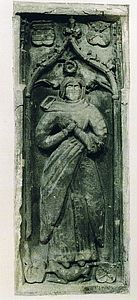
5. Memorial slab with the picture of a noblewoman, presumably Hildegard von Sierck,
spouse of Gerlach II. von Isenburg; work of a middle-Rhineland workshop (14th century, 3. Case bay, North Side.)




